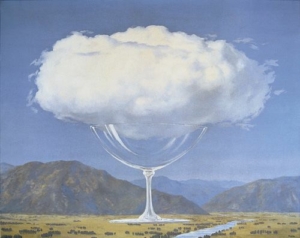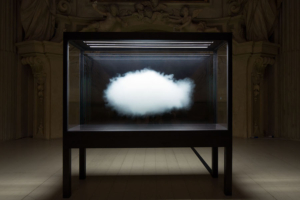CLOUDS: PURE FORM OF DREAM MATERIAL
Clouds are elements that throughout history have always fascinated those who observe them, they represent the outside of the norm, they are without substance, without form and permanence. Their presence in the sky is perceived as something negative: not surprisingly, many metaphors make derogatory use of it. And instead, for a very long time, clouds represented the very image of dreams, of spiritual pilgrimage, so much so that they were considered, in some religions, a vehicle for meditation and a place of visions.
Poets, painters, philosophers and mystics, whether from the East or the West, have all come across this theme sooner or later. Symbols of fertility and sweetness (due to the rain they contain and hide), as well as references to the invisible, clouds inspire melancholy because they recall the fleeting nature of things and at the same time instill, in those who contemplate them, a feeling of joy thanks to their lightness and their metamorphoses. They are a constant invitation to research and contemplation.
Starting from the assumption that art is the mirror of the vision of the world, the way in which the sky that is represented changes depending on the fashions, on the knowledge of the subversion that the artist wanted to assume. Changing clouds and palettes means changing the conception of the present. In this article we will see three very different cases on interpreting these forms.
SURREALISM: MAGRITTE – SENSITIVE CLOUDS

In “Sensitive Corde”, a frothy white cloud is placed on a crystal cup, capable of mixing the surrealist juxtaposition of apparently incongruous objects with the naivety of a child who questions himself about the nature of clouds:
Looking at the clouds and wondering why they are there means looking at the world and not submitting to it with resignation, it means approaching things not only with the desire to understand them, but also to be an active part of them.
What keeps the clouds hanging in the sky? A transparent glass.
Magritte breaks the rules of visual language to reconstruct and re-propose them in a new symbolic key. The objects live from the hidden meanings that represent them and are revealed by his clear and serene painting.
The painting is titled “The sensitive rope”, precisely because it questions one of those questions that we ask ourselves in childhood, when everything is still possible in the world: how do the clouds fly over our heads, to be light and without weight? Will he hold a rope for her?
The lightness of the question merges with the lightness of the answer, in a composition that proposes the vision not of a dream, but of a possibility.
If you don’t see it it doesn’t mean it doesn’t exist, this is what Magritte tells us, and he tells us that there is always a hidden possibility that can explain the inexplicable, a solution to doubt, a surprise behind a certainty. Because the mountains are enough to themselves while the clouds need someone to watch them to take shape.
JAN FABER: THE MEASUREMENT OF CLOUDS

The true nature of man’s art and thought is his continuous search for identity and discovery of eternity, through the study of the most ephemeral and poetic elements of nature. This happens largely with the ability to dream, to transcend time and space through imagination. Jan Fabre celebrates the ability to imagine, dream and know, rising beyond our destiny as human beings with “The Man Who Measures the Clouds”.
A work that investigates man’s ability and will to catalog things, to name them, to make nature a “landscape”, to bring the possible of geometry – in this case – into the impossibility of air.
Inspired by the statement that the ornithologist Robert Stroud made upon his release from Alcatraz prison, when he declared that he would dedicate himself to “measuring the clouds”.
The work lends itself to being read as «a metaphor of the artist who tries to capture the impossible through his work», to quote Fabre himself, taking inspiration from the philosopher Protagoras’ assertion «Man is the measure of all things, of those that are because of what they are, and of those that are not because of what they are not”. For the Greeks, man is the unit of measurement of the mutual relationship between objects and, in the same way, Fabre’s man places himself as the measure of all things, in homage to the greatness of the human imagination.
From the Greeks to today, man has been attracted by monumentality: bigger, more visible and more powerful. Does Jan Fabre use the enormous height of this sculpture to make the extent of human endeavor physically visible? Man always wants to measure himself and loves to excel, it is impossible to overlook these facts in a historic city like Venice.
The subject is a man in contemporary clothes who, stretching his arms towards the sky, stands on a library ladder, holding a surveyor’s ruler with both hands, in the gesture of measuring celestial objects. The figure appears to represent Fabre himself, but is in fact modeled on the body of his younger brother, Emiel Fabre, who died at an early age; the resemblance between the two brothers was irrefutable. The longitudinal thrust of the body meets the decisive horizontality of the splint it supports, creating a culmination where a temporary reconciliation between horizontal tension and verticality occurs. The compositional balance echoes the perfection to which man aspires, to the point of placing himself as the unit of measurement of all creation, of pushing himself ever higher, aiming for the sky with his monumental works of art and magnificent architecture who are tangible witnesses of his desire for affirmation.
The silicon bronze work is completed with a gold leaf covering, making it a sort of contemporary idol/icon. The colossal dimensions of the sculpture and its golden radiance restore magnificence to the human enterprise. The use of gold in the Venetian context also brings to mind multiple connections with the history of the city and the men who inhabited it and made it a commercial power over the centuries. In fact, it was in Venice, in 1284, that the first gold coin was minted and remained the point of reference for all European currencies for 600 years. Today, it is in Venice that the ancient gold leaf processing survives, within the only existing workshop in Europe, still able to use the original 18th century techniques.
So who is this measurer of the unknown who deludes himself into being able to understand the greatness of the immeasurable? Jan Fabre leaves the observer with an unresolved doubt, a “creative thought” that pushes us to look upwards to note the indefiniteness of the sky above Venice and of the human perspective itself. Jan Fabre offers us a monument to the measure of the immeasurable. It challenges the viewer to rethink the meaning of proportions
DEMATERIALIZED CLOUDS – LEANDRO ERLICH

Candid, soft and floating. Leandro Erlich’s clouds are imprisoned inside large glass cases, illuminated so that they become protagonists. On the border between dream and reality, the artist proposes a game of poetic illusions.
Born in 1973, the Argentine artist famous throughout the world for his ambiguous and illusory installations, proposes a project based on optical illusions, on what is there but is not there. The cloud display cases seem to invite the viewer to come closer, to touch what is by nature intangible: a beauty suspended in time and space, trapped as if wanting to challenge the laws of physics and nature itself. Erlich’s work is designed so that the public feels part of the magic that materializes before their eyes, in a perpetual alternation of real and surreal
Leandro Erlich delves into the complex relationship that exists between reality and fiction, underlining the inversion of the common perception of what is real and what is not.
Erika Gaburro


